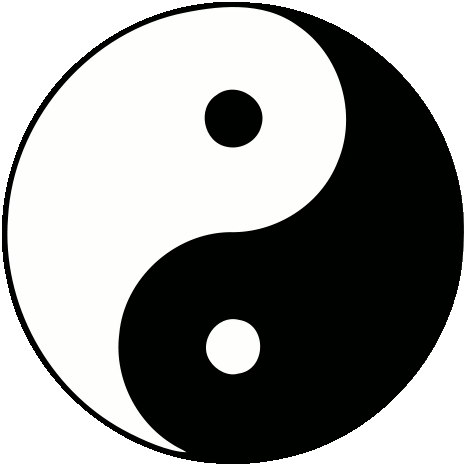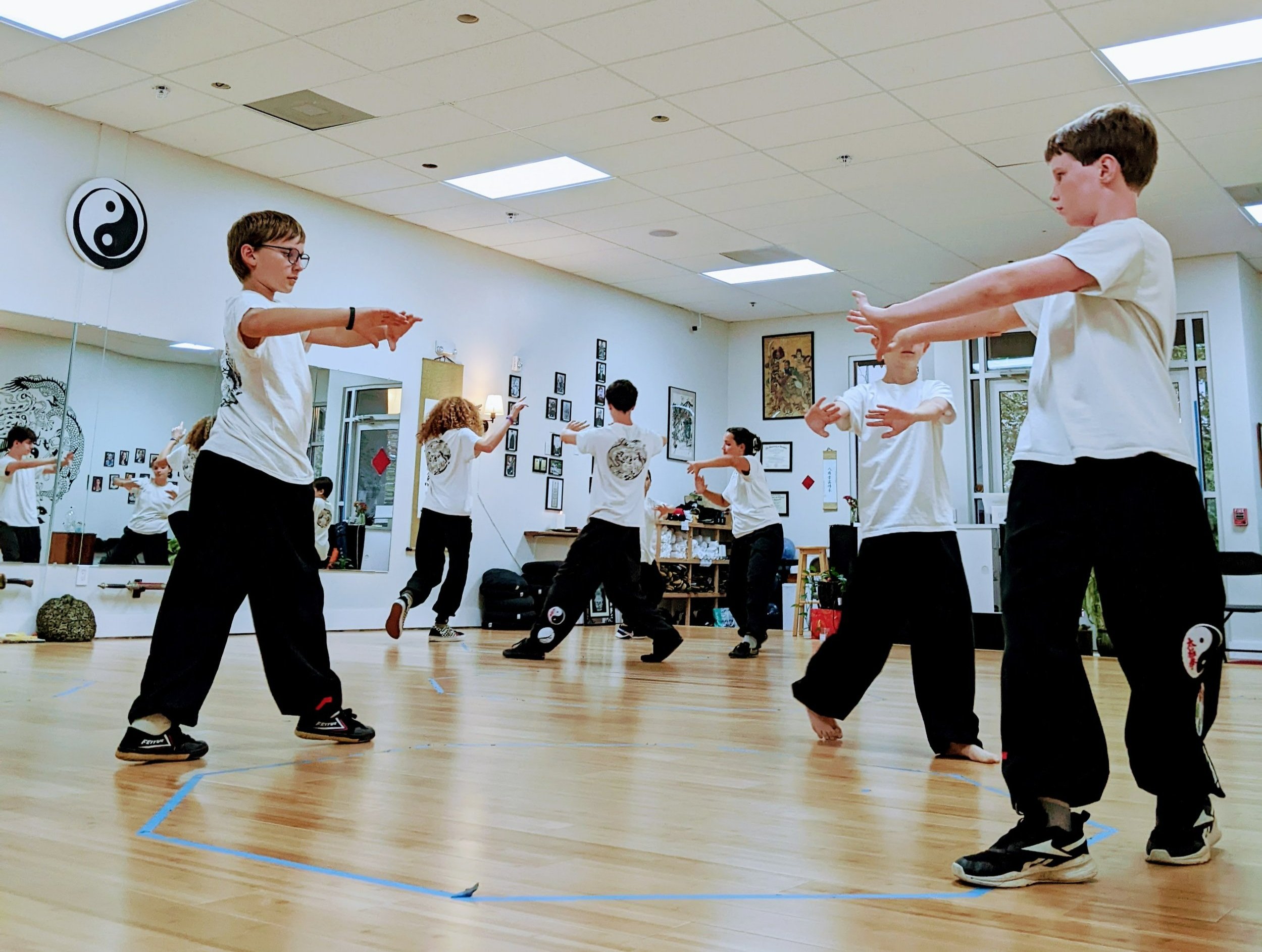
Our Curriculum
Xing Yi Quan
Level 1
Xing Yi Quan (click on the link for more information about this style), or “Mind Formed Fist” is the style of Kung Fu taught in the Level 1 class. Its movements are based on the movements of the Spear, This is the style of Martial Arts taught to the Chinese Military. The forms are easy to learn, but difficult to master.
In this class students learn the Five Element Fists, which teach the five different types of power expressed in Xing Yi, as well as a 5 Element Linking Form, Two Person Form, and four of the twelve animal styles. The second half of the system will be taught in Level 5 after they have had time to develop a high degree of proficiency in the style.
Students also learn Tai Chi stances and concepts to prepare them for Level 2, and Bagua Circle Walking to prepare them for Level 3. We try to keep this class fun with many activities to build strength, whole body awareness, and skills they need to be successful in the art. Class ends with a short Kung Fu story coming from Tao philosophy, and sitting meditation.
For students to progress to level 2, they must submit a video of them performing the 5 Element forms, Linking Form, and 2 person forms. The reason for this is to encourage practice at home, to teach self reflection and awareness, as well as to teach students how to read the movements of others. In this, they develop a sense of “What is good Kung Fu” and start to become self teachers. “Testing” is more of a formal performance to show friends and family members their hard work and how much they have grown. This helps to develop the skills of public speaking. Testing is difficult regardless, and is important for developing a sense of confidence and self awareness. There is no such thing as failure at our school. Students simply continue to work until they arrive at their destination. Testing promotion fee is $30.
We know that submitting your first videos can be a daunting task so we try to make it easy. Assistant instructors for class will work with students before and after class to help them with material and recording testing videos if they are having a difficult time recording at home. Videos can be submitted by uploading from your phone to Google Drive, then sharing the link with Shifu Aaron.
Class Schedule
XingYiquan - Level 1
Mondays, Tuesdays, and Thursdays 4:00 - 5:00
Baguazhang - Level 2
Wednesdays and Fridays 4:0 - 5:00
Chen Taijiquan - level 3
Mondays 5:30 - 6:30
chen Pao Choi - level 4
Wednesdays 6:15 - 7:15
Weapons
Baguazhang Weapons - Thursdays 5:30 - 6:30
Tai Chi Weapons - Fridays - 5:30 - 6:30
Sparring
Wednesdays - 5:15 - 6:00
Tuition Costs
New Student Special - 2 Month 2 days/ week and Free Uniform for $215
$170/ month for 2 classes/week
$90/ month for 1 class/week
Swimming Dragon Baguazhang
Level 2
Cheng Style Baguazhang (click on the link to find out more about this style) is very circular in nature. In practice it is meant to resemble a swimming dragon. Whereas most martial arts styles only utilize straight line work, Baguazhang moves in circles and spirals (tornado power). In this you are constantly moving behind your opponent and create the ability to fight many opponents simultaneously.
This is the class where students start to learn competitive Push Hands with fixed steps. Push Hands is the sparring of Tai Chi and is similar to wrestling. It was designed as a way to practice martial application without injuring your partner.
The main material for student to be able to demonstrate to be move up to the next level is that they should be able to do the 8 Turning Palms form independently both right handed as well as left handed.
Testing to move into level 3 is the same as for moving into level 2.
Chen Taijiquan
Level 3
Taijiquan roughly translates as Great Polarity Fist and is based on the principles of Yin and Yang. Taiji ( or Tai Chi) uses spiral power for whole body integration. Whereas some Tai Chi styles are slower and focus mostly on health and energy cultivation, Chen Family Tai Chi (click on the link to find out more about this style) does this with more of an emphasis on martial application and change of speed. We are one of the very few schools in the country that teaches Tai Chi to children.
Students in this class learn the first half of Chen Tai Chi Old Frame First Form, or Yi Lu. The second half will be taught later in Level 5. Another big focus of this class is Push Hands practice. Push hands is where martial application of Tai Chi is learned and refined, and is the sparring of Tai Chi. Students start to learn restricted step Push Hands and build on their previous skill level. This is also the class where students start to learn more about martial application and how to utilize the movements of our Kung Fu in a self defense situation. We wait until this stage so that we are certain students have the self control and maturity to learn application that could cause serious injury to another person.
Xing Yi linking form and Bagua 8 turning palms are practiced as a warm up for this class so that students can continue to grow and develop in these styles.
Testing for Level 3 is conducted similarly as in Levels 1 and 2. Students will submit a video of them performing the Tai Chi form showing basic proficiency in being able to demonstrate the form independently.
Pao Choi
Level 4
Pao Choi translates as Cannon Fist. This is the combat form of Chen Tai Chi. It is unknown to many Tai Chi practitioners, as it is much more advanced and rarely taught outside of China. Spirals are tightened and Fa Li (explosive power) is now explored through Tai Chi. When Tai Chi evolves to this level it is said of the movements that one moves like water, strikes like ice, and evaporates like steam. Another way to describe this Kung Fu is “External by way of Internal”
This is the point where kids start to join in the adults classes because at this point they are operating at the same level as the adults. We go through the Taiji form that they learn in Level 3 as a warm up, this time applying speed and issuing power in the same way that Laojia Erlu, or Pao Choi should be practiced once proficiency is developed. Students then learn Pao Choi along with combat application. The last 15 minutes of class are dedicated to competitive Push Hands. We now include free stepping and coach students on how to win and beat an opponent by exploiting their center of gravity.
Sparring
Sparring is excellent for developing timing, speed, and a sense of distance with an opponent. It also gets students used to hitting and getting hit. Because of that, safety is number one. Students in this class wear sparring gear, which includes padded gloves, padded boots, padded helmet, and mouth guard.
We offer Sparring as a separate class dedicated to sparring for the students who would like to build experience with traditional sparring as found in most martial arts schools. We know that not all kids are going to like this aspect of Martial Arts, so by keeping it as a separate class it allows students who are looking for this kind of training to spend time focusing on it without it being mandatory for all students.
Sparring class is available for students who have made it to Level 2 and above. Kids sparring is held on Wednesdays from 5:15 - 6:00, and Old Teens and Adults sparring is held on Wednesday evenings from 7:30 - 8:00. Both classes are taught by Shifu David.
Black Sash
Level 5
Black Sash is the Kung Fu equivalent of Black Belt. Up to this point students have only had to demonstrate basic proficiency in the forms they have learned. To earn the rank of Black Sash, students must submit new videos of them demonstrating the previous material plus some more advanced material. These videos need to demonstrate fluidity as well as a clear understanding of the basics and principles. Students can earn Black Sash in both Cheng Baguazhang as well as Chen Taijiquan. Black Sash is considered the middle level of Kung Fu. There are many levels above this, but to achieve this level is a great accomplishment. To advance to higher levels it is highly recommended that a student start teaching if they have not yet already. The cost for promotion to Black Sash is $75.
Black Sash in Baguazhang
To earn Black Sash in Baguazhang students will move to the adults Baguazhang level 2 class Tuesday evenings at 6:45. In this class they will learn the 8 Mother Palms as well as the 8 Mother Palm Linking Form. They will first earn patch and certificate in the linking form for basic proficiency, then demonstrate clear understanding in the movements for the Linking Form as well as the 8 Turning Palms to earn the rank of Black Sash.
Black Sash in Taijiquan
Students will move into the Adults Tai Chi class on Monday evenings at 6:45 to learn the 2nd half of Old Frame First Form. Once completing that they will work to submit videos of them clearly demonstrating both the First Form, and Second Form (Pao Choi) demonstrating fluidity and a clear understanding of the foundations and principles.
Weapons Class
Weapons Class is an optional class for students who have made it to the level 2 class and are at least 12 years of age. When a student moves to level 3 class, the age requirement changes to the parent’s discretion. This class is only open to new students once or twice a year when we are about to learn a new weapon. In this way all students learn the same material together at the same time. We offer two different Weapons classes - Baguazhang Weapons, and Tai Chi Weapons.
All weapons are taught as an extension of the body and led by the mind. A “Weapon” is a concept. We use these weapons as Tools to improve our Kung Fu while strengthening our body and building greater awareness in ourselves and our surroundings. Weapons training is one of the major pillars of Kung Fu training.
For each weapon we start off learning stances as well as basic drills. From there we expand on these concepts and explore movement through learning traditional forms. Once students start to show fluency and control with their weapon, we move into basic 2 person exercises so that they can grasp application and connection. Finally we explore free form combat with each weapon in a safe, noncompetitive way so as to build real life application skills.













